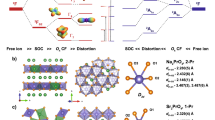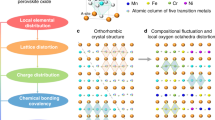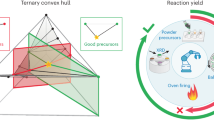Abstract
Praseodymium in the +5 oxidation state is a long-sought connection between lanthanide, early-transition and actinide metal redox chemistries. Unique among the lanthanide series, evidence for molecular pentavalent praseodymium species has been observed in the gas phase and noble gas matrix isolation conditions. Here we report the low-temperature synthesis and characterization of a molecular praseodymium complex in the formal +5 oxidation state, [Pr5+(NPtBu3)4][X−] (where tBu = tert-butyl and X− = tetrakis(pentafluorophenyl)borate or hexafluorophosphate). Single-crystal X-ray diffraction, solution-state spectroscopic, solution magnetometric, density functional theory and multireference wavefunction-based methods indicate a highly multiconfigurational singlet ground state. An inverted ligand field drives this unique electronic structure, which establishes a critical link in understanding the bonding of high-valent metal complexes across the periodic table.

This is a preview of subscription content, access via your institution
Access options
Access Nature and 54 other Nature Portfolio journals
Get Nature+, our best-value online-access subscription
$32.99 / 30 days
cancel any time
Subscribe to this journal
Receive 12 print issues and online access
$259.00 per year
only $21.58 per issue
Buy this article
- Purchase on SpringerLink
- Instant access to full article PDF
Prices may be subject to local taxes which are calculated during checkout




Similar content being viewed by others
Data availability
The data that support the findings of this study are available from the main text and the Supplementary Information. X-ray data are available free of charge from the Cambridge Crystallographic Data Centre under references 2381100 (3b) and 2381101 (3a). Additional spectroscopic, crystallographic and computational data are included in the supplementary materials. Computational coordinates and energies and source data generated during the current study have been deposited in the figshare database (https://doi.org/10.6084/m9.figshare.26894113). Source data are provided with this paper.
References
Jørgensen, C. K. in Oxidation Numbers and Oxidation States (ed. Jørgensen, C. K.) 6–13 (Springer, 1969).
Karen, P., McArdle, P. & Takats, J. Comprehensive definition of oxidation state (IUPAC Recommendations 2016). Pure Appl. Chem. 88, 831–839 (2016).
Keilwerth, M. et al. The synthesis and characterization of an iron(VII) nitrido complex. Nat. Chem. 16, 514–520 (2024).
Wang, G. et al. Identification of an iridium-containing compound with a formal oxidation state of IX. Nature 514, 475–477 (2014).
Leach, I. F. & Klein, J. E. M. N. Oxidation states: intrinsically ambiguous? ACS Cent. Sci. 10, 1406–1414 (2024).
Fieser, M. E. et al. Evaluating the electronic structure of formal LnII ions in LnII(C5H4SiMe3)31− using XANES spectroscopy and DFT calculations. Chem. Sci. 8, 6076–6091 (2017).
Thyssen, P. & Binnemans, K. in Handbook on the Physics and Chemistry of Rare Earths (eds Gschneidner, K. A. et al.) Vol. 41 1–93 (Elsevier, 2011).
Nilson, L. F. & Pettersson, O. Ueber das Atomgewicht und die wesentlichen Eigenschaften des Berylliums. Ber. Dtsch. Chem. Ges. 13, 1451–1459 (1880).
Cheisson, T. & Schelter, E. J. Rare earth elements: Mendeleev’s bane, modern marvels. Science 363, 489–493 (2019).
Gompa, T. P., Ramanathan, A., Rice, N. T. & La Pierre, H. S. The chemical and physical properties of tetravalent lanthanides: Pr, Nd, Tb, and Dy. Dalton Trans. 49, 15945–15987 (2020).
Palumbo, C. T., Zivkovic, I., Scopelliti, R. & Mazzanti, M. Molecular complex of Tb in the +4 oxidation state. J. Am. Chem. Soc. 141, 9827–9831 (2019).
Willauer, A. R. et al. Accessing the +IV oxidation state in molecular complexes of praseodymium. J. Am. Chem. Soc. 142, 5538–5542 (2020).
Rice, N. T. et al. Design, isolation, and spectroscopic analysis of a tetravalent terbium complex. J. Am. Chem. Soc. 141, 13222–13233 (2019).
Rice, N. T. et al. Spectroscopic and electrochemical characterization of a Pr4+ imidophosphorane complex and the redox chemistry of Nd3+ and Dy3+ complexes. Dalton Trans. 51, 6696–6706 (2022).
Boggiano, A. C. et al. A four-coordinate Pr4+ imidophosphorane complex. Angew. Chem. Int. Ed. 63, e202409789 (2024).
Ye, L.-W. et al. Is pentavalent Pr(V) feasible in solid CsPrF6? Dalton Trans. 53, 15198–15204 (2024).
Zhang, Q. et al. Pentavalent lanthanide compounds: formation and characterization of praseodymium(V) oxides. Angew. Chem. Int. Ed. 55, 6896–6900 (2016).
Willson, S. P. & Andrews, L. Characterization of the reaction products of laser-ablated early lanthanide metal atoms with molecular oxygen. Infrared spectra of LnO, LnO+, LnO−, LnO2, LnO2+, LnO2−, LnO3−, and (LnO)2 in solid argon. J. Phys. Chem. A 103, 3171–3183 (1999).
Su, J., Hu, S., Huang, W., Zhou, M. & Li, J. On the oxidation states of metal elements in MO3− (M = V, Nb, Ta, Db, Pr, Gd, Pa) anions. Sci. China Chem. 59, 442–451 (2016).
Hu, S.-X. et al. Pentavalent lanthanide nitride-oxides: NPrO and NPrO− complexes with N≡Pr triple bonds. Chem. Sci. 8, 4035–4043 (2017).
Vent-Schmidt, T. & Riedel, S. Investigation of praseodymium fluorides: a combined matrix-isolation and quantum-chemical study. Inorg. Chem. 54, 11114–11120 (2015).
Rice, N. T. et al. Homoleptic imidophosphorane stabilization of tetravalent cerium. Inorg. Chem. 58, 5289–5304 (2019).
Boggiano, A. C. et al. Structural distortion by alkali metal cations modulates the redox and electronic properties of Ce3+ imidophosphorane complexes. Chem. Sci. 14, 11708–11717 (2023).
Rice, N. T. et al. Comparison of tetravalent cerium and terbium ions in a conserved, homoleptic imidophosphorane ligand field. Chem. Sci. 11, 6149–6159 (2020).
Otte, K. S. et al. Divergent stabilities of tetravalent cerium, uranium, and neptunium imidophosphorane complexes. Angew. Chem. Int. Ed. 62, e202306580 (2023).
Niklas, J. E. et al. A tetrahedral neptunium(V) complex. Nat. Chem. 16, 1490–1495 (2024).
Boggiano, A. C., Niklas, J. E., Bernbeck, M. G. & La Pierre, H. S. U4+/5+/6+ in a conserved pseudotetrahedral imidophosphorane coordination sphere. Inorg. Chem. 64, 2489–2495 (2025).
Aistars, A., Doedens, R. J. & Doherty, N. M. Synthesis and characterization of vanadium(V) mono-, bis-, tris-, and tetrakis(phosphoraniminato) complexes. Inorg. Chem. 33, 4360–4365 (1994).
Hawkeswood, S. B. & Stephan, D. W. Synthesis and characterization of vanadium(V)−phosphinimide complexes. Inorg. Chem. 42, 5429–5433 (2003).
Rehder, D. A survey of 51V NMR spectroscopy. Bull. Magn. Reson. 4, 3383 (1982).
Schubert, E. M. Utilizing the Evans method with a superconducting NMR spectrometer in the undergraduate laboratory. J. Chem. Educ. 69, 62 (1992).
Otte, K. S. et al. Proton-coupled electron transfer at the Pu5+/4+ couple. J. Am. Chem. Soc. 146, 21859–21867 (2024).
Yang, L., Powell, D. R. & Houser, R. P. Structural variation in copper(I) complexes with pyridylmethylamide ligands: structural analysis with a new four-coordinate geometry index, τ4. Dalton Trans. https://doi.org/10.1039/B617136B (2007).
Viste, A. & Gray, H. B. The electronic structure of permanganate ion. Inorg. Chem. 3, 1113–1123 (1964).
Snyder, J. P. Elusiveness of CuIII complexation; preference for trifluoromethyl oxidation in the formation of [Cu(CF3)4]− salts. Angew. Chem. Int. Ed. 34, 80–81 (1995).
Hoffmann, R. et al. From widely accepted concepts in coordination chemistry to inverted ligand fields. Chem. Rev. 116, 8173–8192 (2016).
DiMucci, I. M. et al. The myth of d8 copper(III). J. Am. Chem. Soc. 141, 18508–18520 (2019).
DuBois, J. L. et al. A systematic K-edge X-ray absorption spectroscopic study of Cu(III) sites. J. Am. Chem. Soc. 122, 5775–5787 (2000).
Lemon, C. M. et al. Electronic structure of copper corroles. Angew. Chem. Int. Ed. 55, 2176–2180 (2016).
Lim, H. et al. X-ray absorption spectroscopy as a probe of ligand noninnocence in metallocorroles: the case of copper corroles. Inorg. Chem. 58, 6722–6730 (2019).
Wu, W., De Hont, J. T., Parveen, R., Vlaisavljevich, B. & Tolman, W. B. Sulfur-containing analogues of the reactive [CuOH]2+ core. Inorg. Chem. 60, 5217–5223 (2021).
Pierloot, K., Zhao, H. & Vancoillie, S. Copper corroles: the question of noninnocence. Inorg. Chem. 49, 10316–10329 (2010).
Bhowmick, R., Roy Chowdhury, S. & Vlaisavljevich, B. Molecular geometry and electronic structure of copper corroles. Inorg. Chem. 62, 13877–13891 (2023).
Finney, B. A., Roy Chowdhury, S., Kirkvold, C. & Vlaisavljevich, B. CASPT2 molecular geometries of Fe(II) spin-crossover complexes. Phys. Chem. Chem. Phys. 24, 1390–1398 (2022).
Grimme, S. & Hansen, A. A practicable real-space measure and visualization of static electron-correlation effects. Angew. Chem. Int. Ed. 54, 12308–12313 (2015).
Booth, C. H., Walter, M. D., Daniel, M., Lukens, W. W. & Andersen, R. A. Self-contained Kondo effect in single molecules. Phys. Rev. Lett. 95, 267202 (2005).
Walter, M. D., Booth, C. H., Lukens, W. W. & Andersen, R. A. Cerocene revisited: the electronic structure of and interconversion between Ce2(C8H8)3 and Ce(C8H8)2. Organometallics 28, 698–707 (2009).
Sergentu, D.-C., Booth, C. H. & Autschbach, J. Probing multiconfigurational states by spectroscopy: the cerium XAS L3-edge puzzle. Chem. Eur. J. 27, 7239–7251 (2021).
Krause, L., Herbst-Irmer, R., Sheldrick, G. M. & Stalke, D. Comparison of silver and molybdenum microfocus X-ray sources for single-crystal structure determination. J. Appl. Crystallogr. 48, 3–10 (2015).
SAINT v.8.40B (Bruker, 2016).
Bourhis, L. J., Dolomanov, O. V., Gildea, R. J., Howard, J. A. & Puschmann, H. The anatomy of a comprehensive constrained, restrained refinement program for the modern computing environment—Olex2 dissected. Acta Crystallogr. A 71, 59–75 (2015).
Dolomanov, O., Bourhis, L., Gildea, R., Howard, J. & Puschmann, H. OLEX2: a complete structure solution, refinement and analysis program. J. Appl. Crystallogr. 42, 339–341 (2009).
Kleemiss, F. et al. Accurate crystal structures and chemical properties from NoSpherA2. Chem. Sci. 12, 1675–1692 (2021).
Acknowledgements
The experimental work was supported by a National Science Foundation (NSF) CAREER grant under award number CHE-1943452 (A.C.B., H.T. and H.S.L.P.). H.S.L.P. is an Alfred P. Sloan Research Fellow. The computational work was supported by the US Department of Energy, Office of Science, Office of Basic Energy Sciences, Heavy Element Chemistry Program, under award number DE-SC0025311 (S.R.C. and B.V.). I.A.P. acknowledges the start-up funds and Meyer Early Career Launch Fellowship at Washington State University. Computations supporting this project were performed on high-performance computing systems at the University of South Dakota, funded by NSF award OAC-1626516 (S.R.C. and B.V.) and using the computational resources at the Ohio Supercomputer Center and the ARCC HPC cluster at the University of Akron (C.M.S. and I.A.P.).
Author information
Authors and Affiliations
Contributions
A.C.B. and H.S.L.P. conceived the idea presented in this publication. H.S.L.P., I.A.P. and B.V. supervised the project and acquired funding. A.C.B., H.T. and H.S.L.P. developed the syntheses. A.C.B., J.E.L. and H.W. performed the spectroscopic and electrochemical characterization and analysis. A.C.B., J.E.N. and F.K. performed the crystallographic characterization. C.M.S., S.R.C., B.V. and I.A.P. performed the theoretical calculations and analysis. Analysis and visualization were performed by A.C.B., J.E.N., C.M.S., S.R.C., F.K., I.A.P., B.V. and H.S.L.P. The first draft was written by A.C.B., J.E.N., C.M.S. and S.R.C., with contributions from all authors. The paper was reviewed and edited by H.S.L.P., I.A.P. and B.V. with input from all authors.
Corresponding authors
Ethics declarations
Competing interests
The authors declare no competing interests.
Peer review
Peer review information
Nature Chemistry thanks Nicholas Chilton, Stephan Hohloch and the other, anonymous, reviewer(s) for their contribution to the peer review of this work.
Additional information
Publisher’s note Springer Nature remains neutral with regard to jurisdictional claims in published maps and institutional affiliations.
Extended data
Extended Data Fig. 1 α-spin MO energy diagrams for 4, 1, and 1M+.
AO contributions specified by yellow (Pr) and blue (ligands) fractions in the MO horizontal bars and electrons residing in the occupied MOs (OMOs) by vertical gray lines. The highest occupied ligand-dominant orbital in each complex is shifted to 0 eV for comparison. The extended black box points out eight OMOs describing Pr–N π interactions across the complexes, with the corresponding average Pr AO contributions shown above. The dashed boxes display two lowest unoccupied MOs (UMOs), with the corresponding average Pr AO contributions shown below. Orbital energy degeneracy is set to 0.05 eV to aid visualization. Full unperturbed MO diagrams are depicted in Supplementary Figs. 84–86.
Supplementary information
Supplementary Information
Materials, Supplementary Text, Figs. 1–95 and Tables 1–23.
Supplementary Data 1
Crystallographic data for compound 3a (CCDC 2381101).
Supplementary Data 2
Crystallographic data for compound 3b (CCDC 2381100).
Source data
Source Data Fig. 1
Referenced cyclic voltammetry data.
Source Data Fig. 2
Source UV–vis data.
Rights and permissions
Springer Nature or its licensor (e.g. a society or other partner) holds exclusive rights to this article under a publishing agreement with the author(s) or other rightsholder(s); author self-archiving of the accepted manuscript version of this article is solely governed by the terms of such publishing agreement and applicable law.
About this article
Cite this article
Boggiano, A.C., Studvick, C.M., Roy Chowdhury, S. et al. Praseodymium in the formal +5 oxidation state. Nat. Chem. 17, 1005–1010 (2025). https://doi.org/10.1038/s41557-025-01797-w
Received:
Accepted:
Published:
Issue date:
DOI: https://doi.org/10.1038/s41557-025-01797-w
This article is cited by
-
A high-five for praseodymium
Nature Chemistry (2025)



